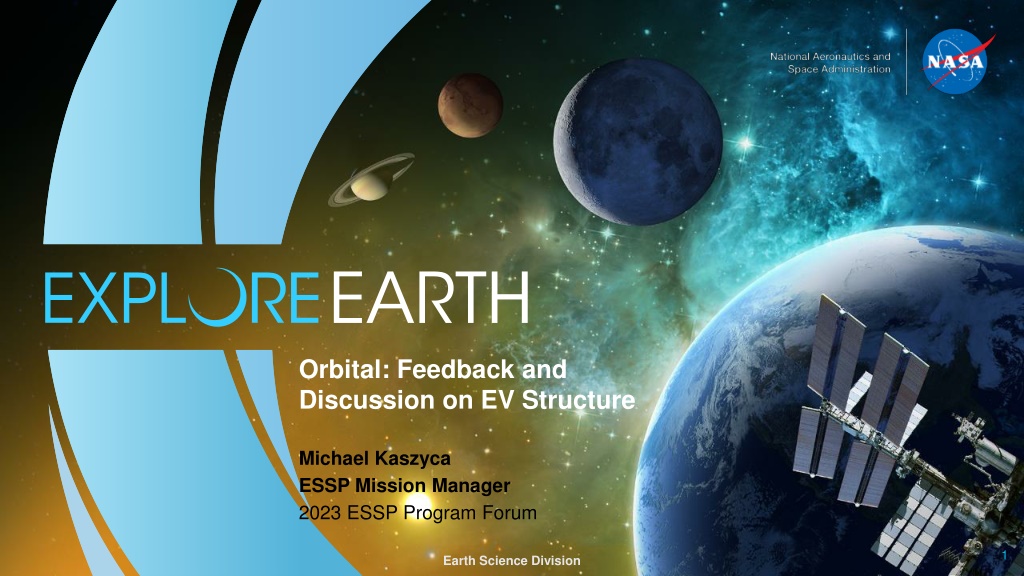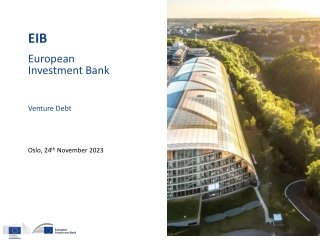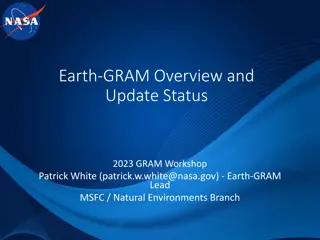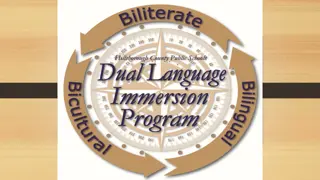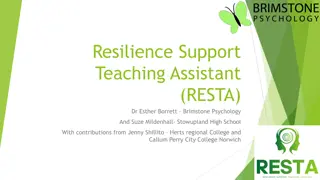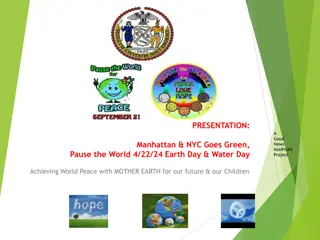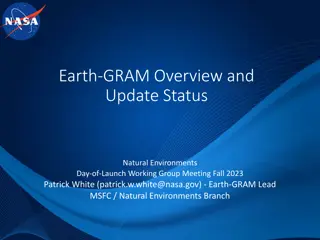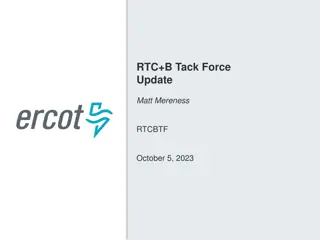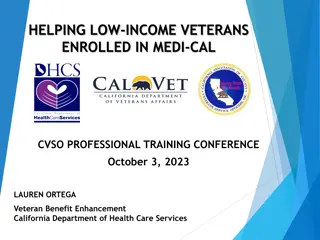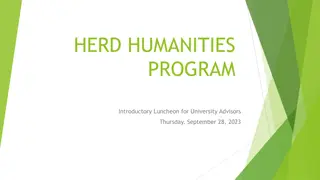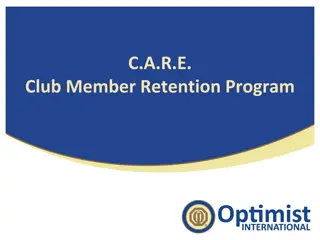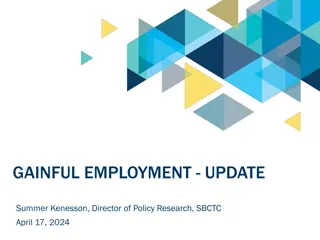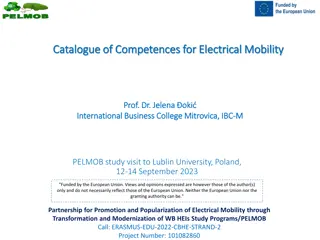Future of NASA's Earth Venture Program
Recent feedback and discussions within NASA's Earth Science Division have revolved around potentially merging EV Mission and EV Instrument efforts, aiming to streamline the mission architecture process. This proposal aligns with past recommendations to emphasize cost-effective, innovative missions over excessive scientific requirements. Key elements include fostering innovation, maintaining a steady stream of opportunities for community participation, and exploring the value of each Venture class. The Earth Venture Foundations seek to restore launch opportunities, facilitate innovative ideas, and expand the pool of qualified individuals while strictly adhering to cost and schedule constraints.
Download Presentation
Please find below an Image/Link to download the presentation.
The content on the website is provided AS IS for your information and personal use only. It may not be sold, licensed, or shared on other websites without obtaining consent from the author. Download presentation by click this link. If you encounter any issues during the download, it is possible that the publisher has removed the file from their server.
Presentation Transcript
Orbital: Feedback and Discussion on EV Structure Michael Kaszyca ESSP Mission Manager 2023 ESSP Program Forum 1 Earth Science Division
Session Overview In Mid-2022 the National Academies released a report*, Lessons Learned in the Implementation of NASA s Earth Venture Class that recommended NASA consider discontinuing the distinction between EV Mission (EVM) and EV Instrument (EVI) efforts. Per this recommendation, the Academies suggested that NASA should solicit proposals that provide the full mission architecture as is currently done with EVM, with the AO listing any specific hosting or launch opportunity that NASA offers to provide (and appropriate costs for these opportunities for teams to account for in their proposals if they do not take advantage of these NASA opportunities). A discussion around this suggestion from the National Academies is being held to give the projects and the ESSP team an opportunity to share initial reactions, potential strategies, and general thoughts around this idea. *https://nap.nationalacademies.org/catalog/26499/lessons-learned-in-the-implementation-of-nasas-earth-venture-class 2 Earth Science Division
Earth Venture Concept 2007 Earth Science Decadal Survey Characterized Venture Class Concept o To restore more frequent launch opportunities and to facilitate the demonstration of innovative ideas and higher-risk technologies, NASA should create a new Venture class of low-cost research and application missions (~$100 million to $200 million). These missions should focus on fostering revolutionary innovation and on training future leaders of space-based Earth science and applications. o Priority for cost-effective, innovative missions rather than those with excessive scientific and technological requirements. o Key to success is maintaining a steady stream of opportunities for community participation in the development of innovative ideas, which requires that strict schedule and cost guidelines be enforced for the program participants. o Assumed $200 million for a new start (or multiple new starts within this value) every 2 years, and each mission assumed to phase in over a 5-year period. 2017 Earth Science Decadal Survey Noted Successes & Desired Assessment o Program has succeeded in fostering innovation and stimulating a vibrant Earth science community through the provision of multiple opportunities. o Fully support the continuation of the EV program in its present form; recommend, however, examining the value of each Venture strand and determine whether the cadence or number of selections of any strand should be modified. Earth Science Division 3
Earth Venture Foundations Restore more frequent launch opportunities, facilitate demonstration of innovative ideas and higher-risk technologies, and expand pool of well- qualified PIs and PMs. Competitively selected, PI-led, and implemented under strict cost- and schedule-constraints; adherence to cost caps/schedule constraints critical to success. No single EV-class selection be an essential element of the ESD flight program. Recommend cadence of ~1 solicitation every 18 months to allow institutions to maintain proposal teams and ensure broad community engagement. *Summary from May 2022 National Academies Lessons-Learned in the Implementation of NASA s Earth Venture Class found here: http://nap.naptionalacademies.org/26499 4 Earth Science Division
Current Earth Venture Structure Focus of discussion is on EVM and EVI 5 Earth Science Division
EV Lessons Learned Report Background o In 2020, NASA requested the National Academies examine the EVI and EVM elements of Earth Ventures and report on lessons learned. o In 2022, the National Academies issued the report Lessons Learned in the Implementation of NASA's Earth Venture Class. (https://doi.org/10.17226/26499) EV Structure Recommendation (Recommendation 3.3 in Report) o In future EV Announcements of Opportunity (AOs), NASA should consider discontinuing the distinction between EVM and EVI proposals. o NASA would then solicit proposals that provide the full mission architecture as is currently done with EVM. o The AO should list any specific hosting or launch opportunity that NASA offers to provide; EV teams would have the option to incorporate these opportunities in their proposals, accounting for their cost to ensure a level competition against proposals that do not take advantage of such NASA-provided accommodation(s). NASA Response Provided (March 2023) o To ensure the impacts to both NASA and the broader science community are fully understood, NASA will assess and study this recommendation in anticipation of the next EVI or EVM AO release. 6 Earth Science Division
Difference Between EVI and EVM Primary Differentiation is Related to Access to Space (ATS) o ATS includes spacecraft, integration, launch, on-orbit operations support. o EVI: NASA provides spacecraft (if applicable) and launch vehicle and covers costs for integration of instrument to NASA-selected platform (i.e., these accommodations costs excluded from PI-managed cost cap). o EVM: Considered complete missions where PI is generally* responsible for arranging entire effort, including spacecraft, launch, and associated integration requirements (costs of which are within the PI-managed cost cap). *Current EVM AOs do allow for proposers to choose between NASA-provided launch services, with an associated reduction to the PI-managed cost cap, or to choose a non-NASA launch service through a PI- arranged and managed approach. Original Vision for Differentiation o To provide PI s an opportunity to develop an instrument (only) to obtain the desired science without directly managing the complexities of an entire mission (under an EVI) or to manage the entire mission (under an EVM). o Help develop depth and breadth of PI community by allowing PIs with greater experience to take on the more complex management aspects of EVM efforts if so desired. 7 Earth Science Division
Discussion Topics Thoughts on current EVI and EVM structure. Good? Bad? Ugly? Ideas for potential future structures Thoughts on cost cap amounts versus number of selections per round (budget driven). Cadence of opportunities (e.g., more frequent, potentially smaller cost caps or less frequent, potentially larger cost caps)? Access to space implications (e.g., costs, flexibility, opportunities). Who should provide spacecraft? Should NASA provide alternatives in AO and allow PI s to choose approach or should NASA dictate singular approach? 8 Earth Science Division
Backup: Earth Science/EV Portfolio Snapshot 9 Earth Science Division
Earth Science Flight Opportunities Open solicitation/In review Completed solicitation Mission Mission Type Release Selection Major Milestone EVS Sustained sub-orbital investigations (~4 years) EVS-1 (EV-1) (AirMoss, ATTREX, CARVE, DISCOVER-AQ, HS3) 5 Suborbital Airborne Campaigns 2009 2010 Completed KDP-F EVM-1 (CYGNSS) Class D SmallSat Constellation 2011 2012 Launched Dec. 2016 EVI-1 (TEMPO) Class C Geostationary Hosted Instrument 2012 2012 Launched Apr. 2023 EVM EVI-2 (ECOSTRESS & GEDI) Class C & Class D ISS-hosted Instruments 2013 2014 Launched June & Dec. 2018 Complete, self-contained, small missions (~4 years) EVS-2 (ACT-America, ATOM, NAAMES, ORACLES, OMG, CORAL) 6 Suborbital Airborne Campaigns 2013 2014 Completed KDP-F Class C LEO Hosted Instrument & Class D CubeSat Constellation MAIA Inst. Delivered Oct. 2022 TROPICS Launched May 2023 EVI-3 (MAIA & TROPICS) 2015 2016 EVM-2 (GeoCarb) Class D Geostationary Hosted Instrument 2015 2016 N/A Mission Cancelled in Nov. 2022 EVI EMIT launched to ISS July 2022; PREFIRE delivery NLT 2023 Full function, facility-class instruments Missions of Opportunity (MoO) (~3 years) EVI-4 (EMIT & PREFIRE) Class C ISS-hosted Instrument & Class D Twin CubeSats 2016 2018 EVS-3 (ACTIVATE, DCOTSS, IMPACTS, Delta-X, SMODE) 5 Suborbital Airborne Campaigns 2017 2018 Post-deployment phase. EVI-5 (GLIMR) Class C Geostationary Hosted Instrument 2018 2019 Delivery NLT 2024 EVC-1 (Libera) Class C JPSS-Hosted Radiation Budget Instrument 2018 2020 Delivery NLT 2025 EVC Complete missions or hosted instruments targeting continuity measurements (~3 years) EVM-3 (INCUS) Full Orbital 2020 2021 Launch ~2026 EVI-6 (PolSIR) Class D CubeSats 2022 2023 Delivery NLT 2027 Suborbital Airborne Campaigns 2023 2024 N/A EVS-4 Explorer Mission 2023 2025 Launch ~2031 & ~2033 ESE Continuity Measurements 2024 2025 Delivery NLT 2029 EVC-2 Instrument Only 2025 2026 Delivery NLT 2030 EVI-7 ESE(NEW) Medium-size instruments and missions (~2 years) Full Orbital 2025 2026 Launch ~2031 EVM-4 Explorer Mission 2025 2027 Launch ~2034 & 2036 ESE Continuity Measurements 2027 2028 Delivery NLT 2032 EVC-3 10 Suborbital Airborne Campaigns 2027 2028 N/A EVS-5
